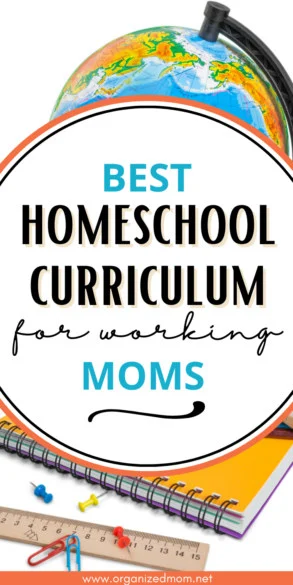You don’t need to be a super-mom to add homeschooling to your daily chores. But it would help if you had a curriculum planned. Homeschooling is structured around a triad of variables: your child, you, and your situation. Within this triangle, the curriculum is the glue. And don’t forget about the child’s role in planning. So, what’s the best curriculum for a working mom?
A working mom’s best homeschool curriculum is simple to implement, easy to follow, and time-saving. A homeschool curriculum is designed for a child, the mom, and the situation. The aim is independent thinking and lifelong learning. Your child is a party to the planning of a homeschool curriculum.
For many moms drawing up a work schedule with a homeschooling curriculum can be daunting. As a working mom, you know the drill. It’s simple, and you must delegate. The best homeschool curriculum is kid-centered. Get your child involved in drawing up a homeschool curriculum and sticking to it. And don’t forget a mom’s best help: time-blocking.

Homeschool Curriculums And The Working Mom
Homeschooling as an alternative way of schooling for all ages challenges conventional public and private school in-class learning. The figure of about 2 million homeschoolers in the States grows yearly. And so is the spread and interest in homeschooling worldwide increasing.
With a rise in the number of homeschoolers, many online resources and paid-for curricula exist. These often can be adapted to come up with a personalized homeschool curriculum.
Homeschooling is new for most moms. With this first-time experience, there’s the pressure to be a parent, tutor-mentor, and, quite often, a working mom. Despite being challenging at first, there’s no reason to dread the process. The process takes time but soon becomes second nature. However, the best homeschool curriculum for working moms is often the more personalized.
Homeschooling curricula needs to give kids independence, which is why most parents choose to homeschool over conventional in-class learning. At the same time, the curriculum has to be designed so that a child takes responsibility for learning outcomes. A core reason for homeschooling is also to boost a kid’s confidence.
A curriculum must be designed as a ‘sequence of planned experiences.’ The curriculum is put in place to motivate a child to be goal-driven and, on an individual level, stimulate interest and really make them hungry for achieving outcomes.
Some of the primary considerations for a curriculum are:
- Child-centred
- Simple To Implement
- Easy To Follow
- Time-saving
Designing a child-centered curriculum doesn’t mean that the mom (even a working one) is left off the hook. The curriculum, above all, remains parent-led. It must be clear what the responsibilities of the homeschoolers are, and the curriculum needs to spell this out. And there’s work and leisure time too.
Child-centered Homeschool Curriculum For Working Mom
A curriculum that works best is child-centered but doesn’t overlook the fact that homeschooling is parent-led, which in this case is the working mom. As much as parents want to make homeschooling enjoyable, this can only be done if the curriculum is well thought out. The curriculum must be planned with the child’s interests and needs as well as those of the working mom.
As a starting point, homeschooling parents need to think of how their child learns best. Mostly younger kids like to learn through play. But there’s more to homeschooling and learning than meets the eye. This also means that the best homeschool curriculum for a working mom will consider what might be homeschooling’s blueprint: how kids learn.
Kids have different styles of learning which can be summed up as follows:
- Visual learners: learning with colorful graphics, pictures
- Auditory learners: sounds (music and stories); even discussions
- Kinaesthetic learners: movement play is part of the learning (‘hands-on‘ learning)

On top of knowing how your kid learns best, a homeschooler’s mom needs to be open-minded to follow the interests of their child in compiling a curriculum. That’s why bringing the kid on board to brainstorm and plan the curriculum is essential (see below).
Some parents consider learning styles, such as what curriculum suits their right- or left-brain learner. The overall strategy in getting the best fit for a curriculum is to get a child to be confident and learn independently. This is the way to plant the seeds for future and continuous learning – a key outcome of homeschooling in the first place.
Different Age-groups Need Different Homeschool Curricula
As much as a curriculum must be interest-led (as seen above), the curriculum has to include choices for all homeschoolers to achieve a level of learning to be stimulating and avoid boredom.
There are specific curricula for young, middle, and high school homeschoolers, even those with an eye on going to college or the workplace.
Child-centered Homeschool Curriculum
An essential part of homeschooling is child-centered learning. This is primarily interest-led, which in the case of homeschooling, is why this learning method is singled out and chosen above the traditional public or private school environments. A core principle of homeschooling is that an interest-led curriculum doesn’t dampen a child’s innate desire to acquire knowledge and learn.
Homeschooling’s child-centered curriculum piques the kids’ interest, and the best curriculum keeps homeschooling flexible.
Besides the kid’s interests, the curriculum needs to consider the following:
- Age-appropriate learning
- Learning style preferences and personality types(see above)
In some cases, the best curriculum incorporates preschool, Kindergarten, and middle school curricula. Here educational models like STEM (science-technology-engineering-maths) and also STEAM (science-technology-engineering-arts-maths) guide homeschool facilitators (in this case, the working mom). The guidelines follow k-12 education – from Kindergarten to Grade 12.
Ideal Homeschooling Curricula
The best homeschool curriculum enriches the homeschooler’s understanding, adds value, and enhances their skills. The curriculum needs to be personalized to ensure self-reliance and doesn’t forget about the layout. You want an outline visible at a glance – a show of the months and even daily plans.
Remember, too, homeschooling isn’t compartmentalized. A homeschooler’s sudden Eureka moment can be pursued at any time and doesn’t need to be put off till the next day. Also, a homeschool curriculum can be structured with the freedom to meet children’s needs. Decide on what works best.
When it comes to the teaching and learning side, the stand-out features of the best homeschool curricula involve:
- Active learning: not a passive learning experience
- Experiential learning: involves thinking and reflecting on what’s learned
- Discovery learning: deals with real-life problem-solving
- Integrated learning: non-prejudicial learning
- Integrative learning: making connections on an interdisciplinary level
In active learning, the homeschooler is more than an observer and gets involved. The homeschooler must be involved and not just a passive onlooker. The experiential learner can reflect back and say what they think about something. Their viewpoint matters. The homeschooler doesn’t rote learn and is expected to engage with content. The homeschooler thinks about a subject and isn’t passive.
The element of discovery fascinates children and adults. In homeschooling, discovery learning is essential as it gets kids to problem-solve. This learning technique is ideally suited to homeschooling. The pioneers of this 1960s learning model are Jean Piaget, Jerome Bruner, and Seymour Papert.
The strength of a curriculum based on discovery learning is that a homeschooler gets first-hand experiences by doing and being involved rather than sitting back. They can discover for themselves and learn.
There are many layers to learning. Getting homeschoolers to think about different religious groupings and ethnicities is possible in a non-biased curriculum. The stand-out feature of such a curriculum is that of integrated learning. This is a model used to bring about balanced cultural and religious viewpoints.
Integrative learning is arguably the most essential aspect to aspire to in a homeschooling curriculum. This teaching method teaches homeschoolers to connect different subjects and find overlaps. The method counters the narrow way conventional schools teach.
The strength of a well-planned homeschool curriculum is to make space for one-on-one learning. This is essential for some homeschoolers as they don’t feel they’re lagging behind. And they can grasp ideas and concepts much better through the learning approaches outlined above. They also have plenty of time to explore and think as the time slots in homeschooling are open-ended.
Homeschooling Doesn’t Happen In A Vacuum
A homeschool curriculum isn’t confined by the walls of a home. Homeschooling involves various enriching programs and STEM fairs and can even spur youngsters to compete in competitions. Homeschoolers also join sports events and can be coached in whatever sport they like.
Homeschoolers find they have more time at hand to explore their interests. Make sure there are slots given to specify this on a homeschool curriculum.
Extramural, Co-ops, And Socialization
The old saying about all school and no play makes a kid dull holds water. Therefore, a homeschool curriculum has time blocked out for extra murals – art, music, drama, sport, martial arts, ballet, and chess, among many others.
Homeschoolers have a range of extramural activities open to them. This can be debating societies and competitions for middle and high school homeschoolers.
Homeschooling is not fixed to the place where families live. The curriculum also is not place-bound. A homeschooler with a well-thought-out curriculum can learn from anywhere in the world. For working moms, this is an advantage as they, too, can be assured that if the family has to travel, their homeschooling child is not missing out on the curriculum.
It might take adjustment, but the new environment (leisure or work) can add to their homeschooling child’s education. It’s even an opportunity for kids to learn about other places. Also, learn about people there. They can use these experiences to enrich their lives. They don’t have to be bored in new places as these become the new backdrop for their homeschooling.
Many homeschooling communities have social co-ops where parents (and homeschoolers) can share ideas, even about homeschool curricula. These co-ops include opportunities for homeschoolers to meet others.

Homeschool Curriculum For Working Mom
You don’t have to stop breathing when you hear ‘homeschool.’ Start with a to-do list and entitle this: learn how to homeschool. You might also have to deschool – learn to think about homeschooling as the freedom to learn what you want. And that homeschooling is not about grades but lifelong learning.
The curriculum is the key to how you go about ensuring your kid’s future and your sanity. You, too, must feature in the homeschool curriculum. Homeschooling is not without struggles, and this is especially so with older children. This can be stressful, especially for a working mom whose time is tight.
As much as you might want to prioritize individual learning, the curriculum needs to accommodate a working mom too. The homeschooling partnership with a child’s interests and needs also has to acknowledge the role of a mom as a facilitator. The parent-led side of the curriculum is as a project manager if you like.
And sometimes mothers need wings to fly! Their role as facilitators is to inspire and motivate. Homeschooling always is parent-led, as a mentor and facilitator to support kids. Homeschooling is an avenue for growing inter-familial relations and bonding with kids. But the home environment does change the home environment and a working mom’s routines.
Some of the critical considerations for a working mom and homeschool facilitator are:
- Amount of time a working mom has for homeschooling
- Time-blocking: scheduling time for one-on-one sessions and assignments
- Recognizing you need work-time
Of course, even with a time schedule, gremlins sneak in to derail the schedule, placing extra demands on a working mom. Many work late at night. This is not an option, though. Above all, moms must avoid burnout.
Time-blocking As Breathing Space
All moms have had that moment in which they want to pull out every hair on their heads. They have the pressure of work and homeschooling and don’t know how to turn. This is even with a homeschooling curriculum that follows kids’ interests and supposedly makes space for their needs too. And yet there is never enough time.
Take a deep breath. There is a way to combat the chaos. One of the best thought-out strategies is time-blocking. Time-blocking is the opposite of multi-tasking, the super-mom syndrome! And the recipe for success comes straight from innovators Elon Musk and Bill Gates and is about time and focus.
Scheduling what you need to do as a working mom and a homeschooling facilitator can benefit from a dedicated schedule to deal with most often competing tasks.
Conclusion
The best homeschool curriculum brings about mental shifts in homeschoolers and parent-facilitators. Homeschooling is the seedbed for life-long learning. And central to such learning is a path of self-discovery and broader learning.




